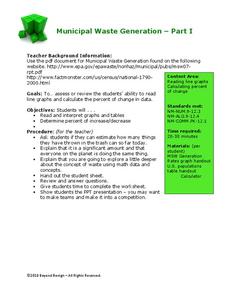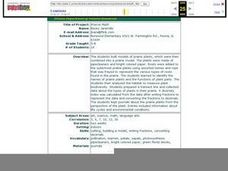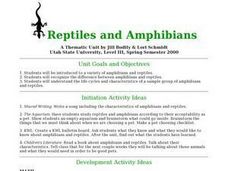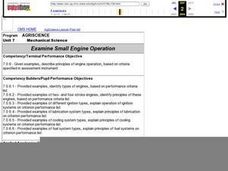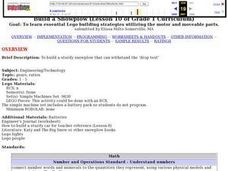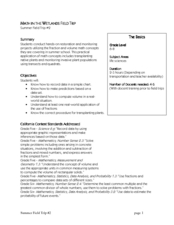Curated OER
Our Solar System - Comparing Planetary Travel Distances
NASA presents a mini-unit on distances in our solar system. It incorporates scientific concepts of gravity, mass, density, and payload while your aspiring astronauts also employ mathematics skills. They calculate speed, they determine...
Beyond Benign
Municipal Waste Generation
Statistically, waste may become a problem in the future if people do not take action. Using their knowledge of statistics and data representation, pupils take a look at the idea of waste generation. The four-part unit has class members...
Curated OER
Birds, Fractions and Percentages
Students study fractions, percentages, spreadsheets, and computers by watching and recording the number of species of birdsseen. They create a spreadsheet to record the results of their one month study.
Curated OER
Filling the Glass (Water, Air, and Fractions)
Learners predict which of two glasses is 1/2 full using visual estimation, height measurement, and liquid measurement methods. Mathematical equations to accurately solve the problem are determined and verified.
Curated OER
Planet Fractions and Scales
In this planets and fractions worksheet, students solve nine problems about the sizes and scales of planets compared to each other using fractions.
Consortium for Ocean Leadership
Measure for Measure
How does your class measure up? Young scientists create a scale drawing of the JOIDES Resolution in a collaborative activity. The lesson incorporates mathematical principles with deep-sea exploration to focus on enhancing measurement...
Curated OER
Solar Storms-Fractions and Percentages
In this solar storms activity, students find the percentage of X-Flares and Halo CMEs that occurred in solar storms and complete a Venn Diagram comparing the numbers of each.
Curated OER
Galaxies to Scale
In this scales and galaxies activity, students solve 7 problems including finding the size of galaxies in comparison to other galaxies and drawing scale models of the given galaxies to show their relative sizes and shapes.
Lane Community College
Review Sheets: Introductory Physical Science
This hybrid worksheet connects mathematics to a science class. Learners practice solving problems that involve making a variety of conversions. An assortment of questions hits all the calculations needed for a middle school or beginning...
Curated OER
Unit 2 Sun & Stars
Young scholars describe stellar objects using terms such as stars, planets, satellites, orbits and light. For this sun and stars unit, students research stellar objects through seven individual lessons discovering star characteristics,...
Curated OER
Sizing Up the Supersize Croc
Students examine and compare traits of humans and crocodiles. In this crocodile lesson students use a ratio to estimate the height of a person and compare that to a crocodile.
Chicago Botanic Garden
Weather or Not
What is the difference between weather and climate? This is the focus question of a lesson that takes a deeper look at how weather data helps determine climate in a region. Using weather and climate cards, students decide...
Curated OER
Scale/Ratio
Investigate the use of ratios in scale drawings. Learners scale objects up or down using ratios then find the actual size of something using ratios. They apply their knowledge of ratios as they make their own telescopes in science...
Curated OER
Prairie Math
Students work together to build models of prairie plants. Using the model, they estimate the height and then measure them using metric and standard units. They write a fraction to represent their part of the whole set and compare and...
Curated OER
Solutions
In this solutions worksheet, students calculate molality and mole fraction. Students define colligative property and determine what affects the solubility of gas in solvents. This worksheet has 2 short answer questions and 9 problems to...
Curated OER
"Water is Life" Global Water Awareness
Young scholars examine and calculate the percentage of potable water remaining on the earth. In this ecology and geography lesson, students brainstorm the main factors affecting water distribution. Young scholars use mathematical problem...
Curated OER
The Anaconda
Learners examine basic facts about the anaconda. They discuss the length of an anaconda, estimate the length of 33 feet, compare their estimate to the actual length, and decorate the paper snake with colored scales.
Curated OER
Mechanical Science - Small Engine Operation
Students experiment with two- and four-stroke engines. They conduct experiments to determine how atmospheric pressure affects the engine's running capability. Further tests are conducted to asses proper llubrication and its affects on...
Curated OER
Identify Plant Nutrient Requirements
Students are given standard elemental nutrients, identify plant nutrient requirements based on criteria outlined in assessment instructment. They, are given standard elemental nutrients, provide all means and chemical symbols of plant...
Curated OER
Saving Money Through Mathematics
Third graders discuss light sources and collect data about energy sources. They compare data and create a multiple line graph showing energy used by light sources for each student in the group. They present their graphs and write a...
Curated OER
Build a Snowplow
Students design and build a snowplow using LEGO materials. They compete in an Engineer's Challenge to clear a path through Styrofoam peanuts.
Curated OER
Piece of the Sky: Introduction for Making S'COOL Observations
Young scholars observe and discuss cloud cover. They identify percent of cloud cover, calculate cloud cover by fraction and convert to a percent, and compare their models with the current real sky cloud cover.
Curated OER
How Cool Is Your Environment?
Pupils study the formulas for calculating heat energy and how to convert Celsius to Fahrenheit. They apply the formulas on a worksheet.
Curated OER
Math in the Wetlands Field Trip
Get your class out in the environment for hands on math activities. In this wetlands lesson, learners transplant native plants, calculate how much soil is needed, and perform math activities based on this experience. They then make...

